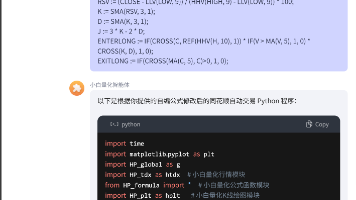大模型agent-从0开始-学习记录
普通调用的方式有很多种框架,对于qwen有vllm和transformer都可以调用,因为transformer这里调用失败,所以主要实验vllm api的方式。微调前要构造训练数据,这里的数据推荐使用sharegpt的格式,因为使用的是llama-factory的框架训练,所以训练常用填充格式如下,参考。调用前需要定义函数,并写好详细的工具描述,并进行微调,如果是模型给定好的接口函数不需要微调,
参考推荐:
- 一文读懂LLM API应用开发基础(万字长文)-CSDN博客
- 使用 LLaMA-Factory 实现对大模型函数调用功能_glaive-function-calling-CSDN博客
- Function Calling - Qwen
下载大模型
如果使用在线的,则去申请对应模型的api_key即可,有些需要收费。
下载需要的模型,这里以qwen2-7B为例
qwen2-7B下载网址:https://huggingface.co/Qwen/Qwen2-7B/tree/main
跟着这里的指令按照即可

模型部署
普通调用的方式有很多种框架,对于qwen有vllm和transformer都可以调用,因为transformer这里调用失败,所以主要实验vllm api的方式
api调用的,需要安装vllm环境
pip install vllm
vllm部署指令
CUDA_VISIBLE_DEVICES=2,3 vllm serve /模型地址 --served-model-name 模型名字 --port 8001
参数解释:
用的哪些显卡 vllm serve 本地模型地址 --served-model-name 部署模型名字 --port 端口
eg:
CUDA_VISIBLE_DEVICES=1 vllm serve /home/yiya_luo/models/Qwen2 --served-model-name qwen2-test --port 8000
如果使用的是llama-factory框架微调训练的,可以用这条指令部署
CUDA_VISIBLE_DEVICES=2,3 API_PORT=8008 llamafactory-cli api --model_name_or_path 本地模型地址 --template qwen2 --infer_backend vllm --vllm_enforce_eager
测试,单个问题curl:
curl <http://localhost:8008/v1/chat/completions> -H "Content-Type: application/json" -d '{
"model": "qwen2-test",
"messages": [
{"role": "system", "content": "你是一个有用的小助手"},
{"role": "user", "content": "新中国成立是哪一年?"}
],
"temperature": 0.7,
"top_p": 0.8,
"repetition_penalty": 1.05,
"max_tokens": 512
}'
工具调用
调用前需要定义函数,并写好详细的工具描述,并进行微调,如果是模型给定好的接口函数不需要微调,这里操作的是需要自定义的。
微调
数据构造
微调前要构造训练数据,这里的数据推荐使用sharegpt的格式,因为使用的是llama-factory的框架训练,所以训练常用填充格式如下,参考https://github.com/hiyouga/LLaMA-Factory/blob/main/data/README.md
环境安装直接pip install -r requirement.txt就好,最好是新建一个空的环境安装,有些包容易冲突一个个装
#格式,如果多轮对话的话,
[
{
"conversations": [
{
"from": "human",
"value": "人类指令"
},
{
"from": "function_call",
"value": "工具参数"
},
{
"from": "observation",
"value": "工具结果"
},
{
"from": "gpt",
"value": "模型回答"
}
],
"system": "系统提示词(选填)",
"tools": "工具描述(选填)"
}
]
例子
{
"conversations": [
{
"from": "human",
"value": "我需要为John Doe生成一张发票。他购买了2个苹果,每个$1,以及3根香蕉,每根$0.5。"
},
{
"from": "function_call",
"value": "{\\"name\\": \\"generate_invoice\\", \\"arguments\\": {\\"customer_name\\": \\"约翰·多伊\\", \\"items\\": [{\\"name\\": \\"苹果\\", \\"quantity\\": 2, \\"price\\": 1}, {\\"name\\": \\"香蕉\\", \\"quantity\\": 3, \\"price\\": 0.5}]}}"
},
{
"from": "observation",
"value": "{\\"invoice_id\\": \\"INV12345\\", \\"customer_name\\": \\"约翰·多伊\\", \\"items\\": [{\\"name\\": \\"苹果\\", \\"quantity\\": 2, \\"price\\": 1, \\"total\\": 2}, {\\"name\\": \\"香蕉\\", \\"quantity\\": 3, \\"price\\": 0.5, \\"total\\": 1.5}], \\"total\\": 3.5, \\"status\\": \\"生成\\"}"
},
{
"from": "gpt",
"value": "发票已成功生成。发票编号为INV12345。约翰·多伊的总金额为$3.5。发票包含2个苹果,总金额为$2,以及3根香蕉,总金额为$1.5。"
}
],
"tools": "[{\\"name\\": \\"generate_invoice\\", \\"description\\": \\"生成发票\\", \\"parameters\\": {\\"type\\": \\"object\\", \\"properties\\": {\\"customer_name\\": {\\"type\\": \\"string\\", \\"description\\": \\"客户名称\\"}, \\"items\\": {\\"type\\": \\"array\\", \\"items\\": {\\"type\\": \\"object\\", \\"properties\\": {\\"name\\": {\\"type\\": \\"string\\", \\"description\\": \\"The item name\\"}, \\"quantity\\": {\\"type\\": \\"integer\\", \\"description\\": \\"The quantity of the item\\"}, \\"price\\": {\\"type\\": \\"number\\", \\"description\\": \\"The price per unit\\"}}, \\"required\\": [\\"name\\", \\"quantity\\", \\"price\\"]}}}, \\"required\\": [\\"customer_name\\", \\"items\\"]}}, {\\"name\\": \\"generate_password\\", \\"description\\": \\"生成随机密码\\", \\"parameters\\": {\\"type\\": \\"object\\", \\"properties\\": {\\"length\\": {\\"type\\": \\"integer\\", \\"description\\": \\"密码的长度\\"}}, \\"required\\": [\\"length\\"]}}]"
},
数据构造好后,需要把数据描述添加的数据集文件中,
"数据集名称": {
"file_name": "data.json",
"formatting": "sharegpt",
"columns": {
"messages": "conversations",
"system": "system",
"tools": "tools"
}
}
例如:

微调
数据格式保持一致的话就可以开始微调了
单卡微调指令参考:使用 LLaMA-Factory 实现对大模型函数调用功能_glaive-function-calling-CSDN博客
python src/train_bash.py \\
--stage sft \\
--do_train True \\
--model_name_or_path /models/Qwen1.5-4B \\
--finetuning_type lora \\
--template qwen \\
--dataset_dir data \\
--dataset glaive_toolcall,alpaca_gpt4_en,alpaca_gpt4_zh,oaast_sft_zh \\
--cutoff_len 1024 \\
--learning_rate 5e-05 \\
--num_train_epochs 2.0 \\
--max_samples 50000 \\
--per_device_train_batch_size 2 \\
--gradient_accumulation_steps 4 \\
--lr_scheduler_type cosine \\
--max_grad_norm 1.0 \\
--logging_steps 100 \\
--save_steps 1000 \\
--warmup_steps 0 \\
--optim adamw_torch \\
--report_to none \\
--output_dir saves/Qwen1.5-4B/lora/train_2024-04-20-15-30-29 \\
--fp16 True \\
--lora_rank 8 \\
--lora_alpha 16 \\
--lora_dropout 0.1 \\
--lora_target all \\
--plot_loss True
多卡就是把python 改成:torchrun --nproc_per_node=8
推理
微调后的模型进行部署,部署后进行定义函数进行调用,调用方式有:
open ai框架,参考https://github.com/hiyouga/LLaMA-Factory/blob/main/scripts/test_toolcall.py
import json
import os
from typing import Sequence
from openai import OpenAI
from transformers.utils.versions import require_version
require_version("openai>=1.5.0", "To fix: pip install openai>=1.5.0")
def calculate_gpa(grades: Sequence[str], hours: Sequence[int]) -> float:
grade_to_score = {"A": 4, "B": 3, "C": 2}
total_score, total_hour = 0, 0
for grade, hour in zip(grades, hours):
total_score += grade_to_score[grade] * hour
total_hour += hour
return round(total_score / total_hour, 2)
def main():
client = OpenAI(
api_key="{}".format(os.environ.get("API_KEY", "0")),
base_url="<http://localhost>:{}/v1".format(os.environ.get("API_PORT", 8000)),
)
tools = [
{
"type": "function",
"function": {
"name": "calculate_gpa",
"description": "Calculate the Grade Point Average (GPA) based on grades and credit hours",
"parameters": {
"type": "object",
"properties": {
"grades": {"type": "array", "items": {"type": "string"}, "description": "The grades"},
"hours": {"type": "array", "items": {"type": "integer"}, "description": "The credit hours"},
},
"required": ["grades", "hours"],
},
},
}
]
tool_map = {"calculate_gpa": calculate_gpa}
messages = []
messages.append({"role": "user", "content": "My grades are A, A, B, and C. The credit hours are 3, 4, 3, and 2."})
result = client.chat.completions.create(messages=messages, model="test", tools=tools)
if result.choices[0].message.tool_calls is None:
raise ValueError("Cannot retrieve function call from the response.")
messages.append(result.choices[0].message)
tool_call = result.choices[0].message.tool_calls[0].function
print(tool_call)
# Function(arguments='{"grades": ["A", "A", "B", "C"], "hours": [3, 4, 3, 2]}', name='calculate_gpa')
name, arguments = tool_call.name, json.loads(tool_call.arguments)
tool_result = tool_map[name](**arguments)
messages.append({"role": "tool", "content": json.dumps({"gpa": tool_result}, ensure_ascii=False)})
result = client.chat.completions.create(messages=messages, model="test", tools=tools)
print(result.choices[0].message.content)
# Based on the grades and credit hours you provided, your Grade Point Average (GPA) is 3.42.
if __name__ == "__main__":
main()
transformer框架(未成功)【transformer框架不需要提前部署】
qwen-agent:Qwen-Agent - Qwen
更多推荐
 已为社区贡献1条内容
已为社区贡献1条内容









所有评论(0)